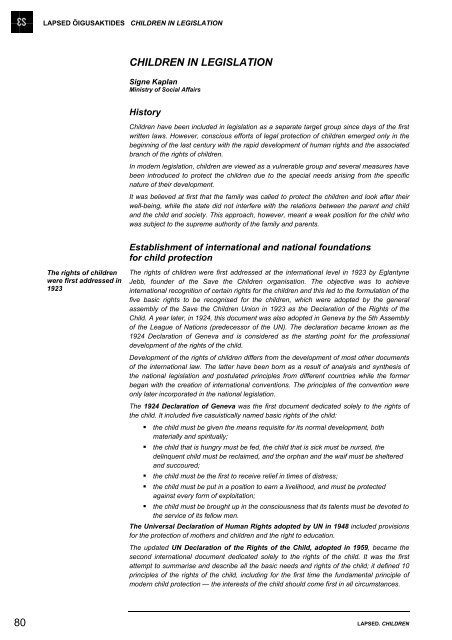LAPSED CHILDREN - Tartu Ãlikool
LAPSED CHILDREN - Tartu Ãlikool
LAPSED CHILDREN - Tartu Ãlikool
- No tags were found...
Create successful ePaper yourself
Turn your PDF publications into a flip-book with our unique Google optimized e-Paper software.
<strong>LAPSED</strong> ÕIGUSAKTIDES <strong>CHILDREN</strong> IN LEGISLATION<br />
<strong>CHILDREN</strong> IN LEGISLATION<br />
Signe Kaplan<br />
Ministry of Social Affairs<br />
History<br />
Children have been included in legislation as a separate target group since days of the first<br />
written laws. However, conscious efforts of legal protection of children emerged only in the<br />
beginning of the last century with the rapid development of human rights and the associated<br />
branch of the rights of children.<br />
In modern legislation, children are viewed as a vulnerable group and several measures have<br />
been introduced to protect the children due to the special needs arising from the specific<br />
nature of their development.<br />
It was believed at first that the family was called to protect the children and look after their<br />
well-being, while the state did not interfere with the relations between the parent and child<br />
and the child and society. This approach, however, meant a weak position for the child who<br />
was subject to the supreme authority of the family and parents.<br />
Establishment of international and national foundations<br />
for child protection<br />
The rights of children<br />
were first addressed in<br />
1923<br />
The rights of children were first addressed at the international level in 1923 by Eglantyne<br />
Jebb, founder of the Save the Children organisation. The objective was to achieve<br />
international recognition of certain rights for the children and this led to the formulation of the<br />
five basic rights to be recognised for the children, which were adopted by the general<br />
assembly of the Save the Children Union in 1923 as the Declaration of the Rights of the<br />
Child. A year later, in 1924, this document was also adopted in Geneva by the 5th Assembly<br />
of the League of Nations (predecessor of the UN). The declaration became known as the<br />
1924 Declaration of Geneva and is considered as the starting point for the professional<br />
development of the rights of the child.<br />
Development of the rights of children differs from the development of most other documents<br />
of the international law. The latter have been born as a result of analysis and synthesis of<br />
the national legislation and postulated principles from different countries while the former<br />
began with the creation of international conventions. The principles of the convention were<br />
only later incorporated in the national legislation.<br />
The 1924 Declaration of Geneva was the first document dedicated solely to the rights of<br />
the child. It included five casuistically named basic rights of the child:<br />
• the child must be given the means requisite for its normal development, both<br />
materially and spiritually;<br />
• the child that is hungry must be fed, the child that is sick must be nursed, the<br />
delinquent child must be reclaimed, and the orphan and the waif must be sheltered<br />
and succoured;<br />
• the child must be the first to receive relief in times of distress;<br />
• the child must be put in a position to earn a livelihood, and must be protected<br />
against every form of exploitation;<br />
• the child must be brought up in the consciousness that its talents must be devoted to<br />
the service of its fellow men.<br />
The Universal Declaration of Human Rights adopted by UN in 1948 included provisions<br />
for the protection of mothers and children and the right to education.<br />
The updated UN Declaration of the Rights of the Child, adopted in 1959, became the<br />
second international document dedicated solely to the rights of the child. It was the first<br />
attempt to summarise and describe all the basic needs and rights of the child; it defined 10<br />
principles of the rights of the child, including for the first time the fundamental principle of<br />
modern child protection — the interests of the child should come first in all circumstances.<br />
80<br />
<strong>LAPSED</strong>. <strong>CHILDREN</strong>

















